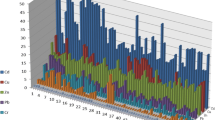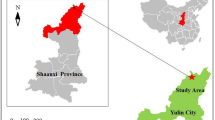Abstract
Soils located adjacent to the Jiaojia gold mine were sampled and analyzed to determine the degree of which they were contaminated by trace elements (Hg, As, Cd, Pb, Cu, and Zn) in Shandong Province, China. All 18 samples exhibited mean Hg, As, Cd, and Pb concentrations in excess of local background values, while the mean concentrations of Cu and Zn were below the background values. In addition, the concentrations of trace elements in gold smelter (GS) soils were higher than in the gold mine (GM) soils. The result from a modified Tessier sequential extraction procedure was that with the exception of Cu in soils near the smelter, the trace elements were predominantly associated with the residual fraction. After residual fraction, most Hg was mainly humic acid and strong organic fraction, while most As was the humic acid. Cd was associated with the water soluble, ion exchange, and carbonate fractions compared with the other trace elements. Furthermore, Cu, Pb, and Zn were more concentrated in the humic acid and Fe/Mn oxide fraction. The fractions of trace elements were affected by soil pH and Ec (Electrical conductivity). The humic acid fraction of Hg as well as the ion exchange fraction of Cd and Zn displayed negative correlations with soil pH. The strong organic fraction of Hg, the Fe/Mn oxide fraction of Cd, and the carbonate fraction of Zn were positively related to the soil Ec. The strong organic fraction and ion exchange fraction of Zn were negatively related to soil Ec. However, the ion exchange and carbonate fractions of As showed significant positive correlations with soil pH. A calculated individual availability factor (A f i) is used; the values of each trace element in the soils are in the following order: Cu > Cd > Pb > Zn > As > Hg. When combined with a risk assessment code, data suggest that Hg, As, Pb, and Zn levels showed low risk for the environment, whereas Cd levels in soils adjacent to the GM and Cu levels in soils adjacent to the GS showed medium risk to the environment, and Cd levels in soils adjacent to the GS exhibited higher environment risk.



Similar content being viewed by others
References
Adokoh CK, Obodai EA, Essumang DK, Serfor-Armah Y, Nyarko BJB, Asabere-Ameyaw A (2011) Statistical evaluation of environmental contamination, distribution and source assessment of heavy elements (aluminum, arsenic, cadmium, and mercury) in some lagoons and an estuary along the coastal belt of Ghana. Arch Environ Contam Toxicol 61(3):389–400
Alvarenga P, Palma P, de Varennes A, Cunha-Queda AC (2012) A contribution towards the risk assessment of soils from the São Domingos mine (Portugal): chemical, microbial and ecotoxicological indicators. Environ Pollut 161:50–56
Anju M, Banerjee DK (2010) Comparison of two sequential extraction procedures for heavy metal partitioning in mine tailings. Chemosphere 78(11):1393–1402
Arenas-Lago D, Andrade ML, Lago-Vila M, Rodríguez-Seijo A, Vega FA (2014) Sequential extraction of heavy metals in soils from a copper mine: distribution in geochemical fractions. Geoderma 230–231:108–118
Arunachalam J, Emons H, Krasnodebska B, Mohl C (1996) Sequential extraction studies on homogenized forest soil samples. Sci Total Environ 181(2):147–159
Barona A, Aranguiz I, Elias A (1999) Assessment of metal extraction, distribution and contamination in surface soils by a 3-step sequential extraction procedure. Chemosphere 39(11):1911–1922
Basta NT, McGowen SL (2004) Evaluation of chemical immobilization treatments for reducing heavy metal transport in a smelter-contaminated soil. Environ Pollut 127(1):73–82
Bi XY, Feng XB, Yang YG, Qiu GL, Li GH, Li FL, Liu TZ, Fu ZY, Jin ZS (2006) Environmental contamination of heavy metals from zinc smelting areas in Hezhang County, western Guizhou, China. Environ Int 32(7):883–890
Breuer K, Melzer A (1990) Heavy metal accumulation (lead and cadmium) and ion exchange in three species of Sphagnaceae. Oecologia 82:461–467
Dai JR, Pang XG, Yu C, Wang CL, Wang ZH, Hu XP (2011) Geochemical baselines and background values and element enrichment characteristics in soils in eastern Shandong Province. Geochemical 40(6):577–587
Dalmacija MB, Prica MDJ, Dalmacija BD, Roncevic SD, Rajic LM (2010) Correlation between the results of sequential extraction and effectiveness of immobilization treatment of lead- and cadmium-contaminated sediment. Sci World J 10:1–19
Dang Z, Liu C, Haigh MJ (2002) Mobility of heavy elements associated with the natural weathering of coal mine spoils. Environ Pollut 118(3):419–426
Dhal B, Thatoi HN, Das NN, Pandey BD (2013) Chemical and microbial remediation of hexavalent chromium from contaminated soil and mining/metallurgical solid waste: a review. J Hazard Mater 250–251:272–291
Favas PJC, Pratas J, Gomes MEP, Cala V (2011) Selective chemical extraction of heavy metals in tailings and soils contaminated by mining activity: environmental implications. J Geochem Explor 111(3):160–171
Filgueiras AV, Lavilla I, Bendicho C (2004) Evaluation of distribution, mobility and binding behaviour of heavy metals in surficial sediments of Louro River (Galicia, Spain) using chemometric analysis: a case study. Sci Total Environ 330(1-3):115–129
He ZL, Yang XE, Stoffella PJ (2005) Trace elements in agroecosystems and impacts on the environment. J Trace Elem Med Biol 19(2-3):125–140
Huang L, Pu X, Pan J, Wang B (2013) Heavy metal pollution status in surface sediments of Swan Lake lagoon and Rongcheng Bay in the Northern Yellow Sea. Chemosphere 93(9):1957–1964
Jain CK (2004) Metal fractionation study on bed sediments of River Yamuna, India. Water Res 38(3):569–578
Jan FA, Ishaq M, Khan S, Ihsanullah I, Ahmad I, Shalirullah M (2010) A comparative study of human health risks via consumption of food crops grown on wastewater irrigated soil (Peshawar) and relatively clean water irrigated soil (lower Dir). J Hazard Mater 179(1-3):612–621
Karak T, Abollino O, Bhattacharyya P, Das KK, Paul RK (2011) Fractionation and speciation of arsenic in three tea gardens soil profiles and distribution of as in different parts of tea plant (Camellia sinensis L.). Chemosphere 85(6):948–960
Kartal Ş, Aydın Z, Tokalıoğlu Ş (2006) Fractionation of metals in street sediment samples by using the BCR sequential extraction procedure and multivariate statistical elucidation of the data. J Hazard Mater 132(1):80–89
Kim B, McBride MB (2006) A test of sequential extractions for determining metal speciation in sewage sludge-amended soils. Environ Pollut 144(2):475–482
Koukina SE, Vetrov AA (2013) Metal forms in sediments from Arctic coastal environments in Kandalaksha Bay, White Sea, under separation processes. Estuar Coast Shelf Sci 130:21–29
Li MS, Luo YP, Su ZY (2007) Heavy metal concentrations in soils and plant accumulation in a restored manganese mine land in Guangxi, South China. Environ Pollut 147:168–175
Rodríguez L, Ruiz E, Alonso-Azcárate J, Rincón J (2009) Heavy metal distribution and chemical speciation in tailings and soils around a Pb–Zn mine in Spain. J Environ Manag 90(2):1106–1116
Salomons W (1995) Environmental impact of metals derived from mining activities: processes, predictions, prevention. J Geochem Explor 52(1-2):5–23
Sanei H, Outridge PM, Stern GA, Macdonald RW (2014) Classification of mercury–labile organic matter relationships in lake sediments. Chem Geol 373:87–92
Santos-Francés F, García-Sánchez A, Alonso-Rojo P, Contreras F, Adams M (2011) Distribution and mobility of mercury in soils of a gold mining region, Cuyuni river basin, Venezuela. J Environ Manag 92(4):1268–1276
Sekabira K, Oryem Origa H, Basamba TA, Mutumba G, Kakudidi E (2010) Assessment of heavy element pollution in the urban stream sediments and its tributaries. Int J Environ Sci Technol 7(3):435–446
Shao YH, Zhang WX, Shen JC, Zhou LX, Xia HP, Shu WS, Ferris H, Fu SL (2008) Nematodes as indicators of soil recovery in tailings of a lead/zinc mine. Soil Biol Biochem 40(8):2040–2046
Susaya J, Kim K, Jung MC (2010) The impact of mining activities in alteration of as levels in the surrounding ecosystems: an encompassing risk assessment and evaluation of remediation strategies. J Hazard Mater 182(1–3):427–438
Wang Y, Shi J, Lin Q, Chen X, Chen Y (2007) Heavy metal availability and impact on activity of soil microorganisms along a Cu/Zn contamination gradient. J Environ Sci 19(7):848–853
Wei C, Wang C, Yang L (2009) Characterizing spatial distribution and sources of heavy metals in the soils from mining-smelting activities in Shuikoushan, Hunan Province, China. J Environ Sci 21(9):1230–1236
Yan DYS, Lo IMC (2011) Enhanced multi-metal extraction with EDDS of deficient and excess dosages under the influence of dissolved and soil organic matter. Environ Pollut 159(1):78–83
Yang YM, Nan ZR, Zhao ZJ, Wang SL, Wang ZW, Wang X (2011) Chemical fractionations and bioavailability of cadmium and zinc to cole (Brassica campestris L.) grown in the multi-metals contaminated oasis soil, Northwest of China. J Environ Sci 23(2):275–281
Zhang C, Yu ZG, Zeng GM, Jiang M, Yang ZZ, Cui F, Zhu MY, Shen LQ, Hu L (2014) Effects of sediment geochemical properties on heavy metal bioavailability. Environ Int 73:270–281
Zhao PY, Gu XX, Deng XH (2007) Genesis and metallogenic model of Jiaojia gold deposit, Shandong. Geol Prospect 43(4):29–35
Acknowledgments
This research was financially supported by the Natural Science Foundation of Shandong Province (No.ZR2012DL09).
Author information
Authors and Affiliations
Corresponding author
Additional information
Responsible editor: Stuart Simpson
Rights and permissions
About this article
Cite this article
Cao, F., Kong, L., Yang, L. et al. Geochemical fractions and risk assessment of trace elements in soils around Jiaojia gold mine in Shandong Province, China. Environ Sci Pollut Res 22, 13496–13505 (2015). https://doi.org/10.1007/s11356-015-4618-0
Received:
Accepted:
Published:
Issue Date:
DOI: https://doi.org/10.1007/s11356-015-4618-0




